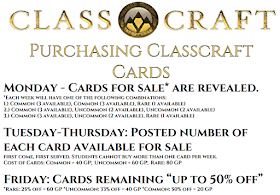Within gamified education circles, there's no doubt that Classcraft is one of the giants. The Canadian-based website started by a former classroom teacher has quickly built its reputation in EdTech circles by offering a role-play RPG framework of gamification that can be utilized within any type of classroom subject area. There are teachers of art, religion, social studies, foreign language, math, and any other subject area imaginable using Classcraft across the globe. If you are looking for a place to start exploring how gamification might work in your own classroom, I encourage you to start with Classcraft.
Of course, if you're reading this post, you're likely already using Classcraft in your own classroom, since it's a blog about how to supplement the already-amazing experience the Classcraft has to offer. While I just started using the website in January, and I admit there are plenty of things I still have to learn, I knew pretty quickly that I wanted to have an additional way to channel creativity and flexibility while continually growing motivation and interest in classroom activities and the structure of Classcraft as a whole. Within my own educational community online, mostly through Twitter, I came across an account called "Age of Heroes Game Feed" (@MrH_AOH). With little effort, I tracked down the teacher behind the supplemental approach to Classcraft, Jason Howse (@MrHExperience) and found out a little more information about his Age of Heroes approach to gamification in his own room. The part that stuck out the most to me was the use of collectable cards which grant powers or abilities otherwise-not-available through the already-determined Classcraft powers. As an adult that admits to playing Magic the Gathering (MtG) growing up, I instantly recognized for the format of Jason's cards as being that of MtG, and he let me know about MtGCardsmith.com, a website allowing for the creation of custom MtG cards.
I was hooked from the moment of creating my first card. The creativity aspects of things were limitless and I had a good feeling that these cards were the aspect that would add that little "extra" element to each of my class's Classcraft gameplay. In addition to the abilities and fun aspects of that the cards added to the game, I also made each cards have a "level," requiring the student using the card to not only have the GP (or GP + AP) to "cast" the card, but also to be of a certain level to do so. This was done with the goal of motivating students to want to gain XP and level up, if they weren't already actively trying to do so. I started by first introducing the cards and providing them, at random, as incentives for doing well and by adding a random event in Classcraft to win them as well, calling it "Play the Hand You're Dealt" (1 random remember of each class - warrior, mage, and healer - wins a random Classcraft Card). When that didn't seem like enough incentive, I followed a similar approach to Jason's AOH game, opening a Classcraft Card store. Each week I offer up 3 cards following a basic rule of having more quantities of common cards than uncommon or rare cards available for each class. In addition, the cost to purchase (separate from their casting cost, labeled as "card cost") is higher for rare cards than it is for uncommon or common. The posting/handout used for this store is shown below.
 |
| Classcraft Card Purchasing Rules (document link in Google Drive) |
 |
| A small sampling of Classcraft Cards used with my classroom game. |
While the period of time during which I have been using these supplemental cards with my own Classcraft game is still very short, I have seen a growth in interest from students. I, too, have become even more excited about the use of Classcraft with my students. In that way, it's been a win-win scenario. It might not be the best fit for your own classroom, and I am aware of that fact. Actually, one of the reasons that I am a Classcraft Ambassador is because the game can be framed and used however it fits best for your own courses and your students. The use of Classcraft Cards, or deciding not to use a similar idea, is no different!
As always, let me know if you have any questions or comments. I'm always interested in hearing about the great things my fellow educators are doing! For more ideas regarding education in general and often EdTech specifically, I encourage you to follow me on Twitter (@ATeachersTeach) and Instagram (@ATeachersTeacher) and to like my facebook page.
-Charlie
(A Teacher's Teacher)

Can I access your cards on MtGCardsmith and use/edit for my own classroom?
ReplyDeleteI cannot wait to dig deep and kickoff utilizing resources that I received from you. Your exuberance is refreshing. domino online
ReplyDelete